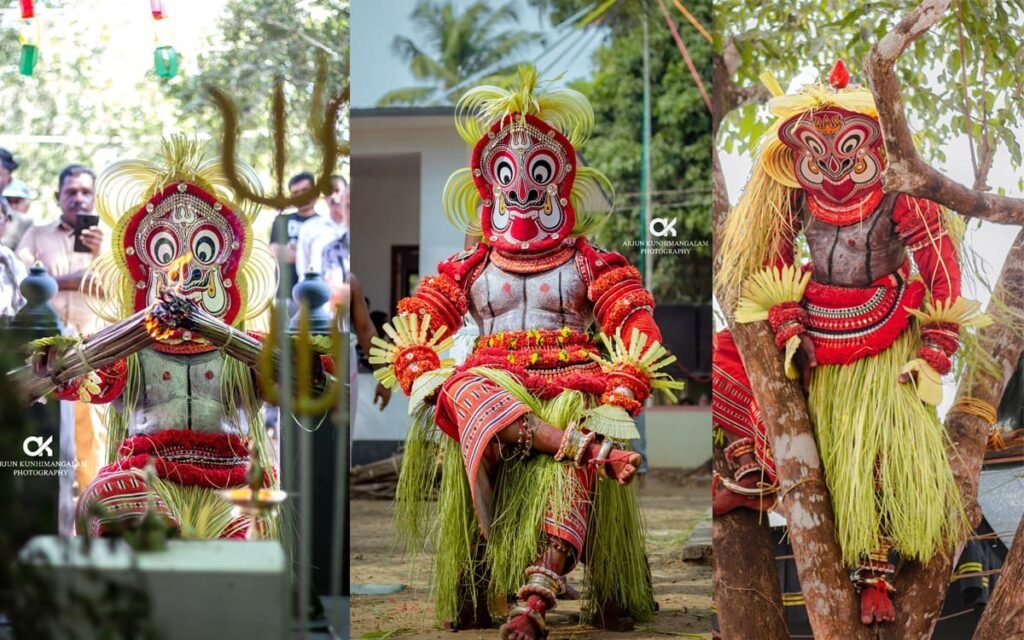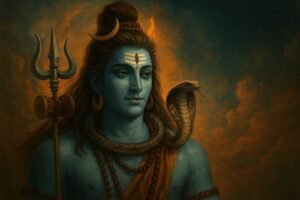Table of Contents
ToggleGulikan Theyyam is known for its presentation and is the most valued theyyam practiced in Kasargod and Kannur districts. While most of the other Theyyams emphasize prosperity and valor to the worldly plane, Gulikan Theyyam, unlike them, gives a conception about death and justice, and protection at the hands of divine power. This may be a cultural manifestation of the villagers in obtaining blessings, direction, and further moral clarity.
What is Gulikan Theyyam?
Gulikan Theyyam is a special type of Theyyam associated with death, cosmic justice, and protection against evil. It is said to represent Gulikan-an evil spirit closely allied to Yama, the Hindu God of Death, and in some cases, he is said to be an attendant to Lord Shiva.
Key Characteristics:
- Yama and Lord Shiva: Gulikan is presented to be either an Avatar of Yama or an emissary of Shiva.
- Religious Role: Gulikan is considered a protector, truth speaker, and divine judge, filling the missing attributes of justice and morality in society.
It is not commercialised as a ritual, but is still practised as a holy rite where the locals gather and perform the ritual.
The Story Behind Gulikan Theyyam
Hindu mythology is the source of Gulikan. According to most versions of the story, Lord Shiva created or sent him to ensure that death is inevitable in order to preserve cosmic balance. When humans attempted to escape death or cheat their fate, Shiva appointed Gulikan to restore order. Thus, Gulikan became the enforcer of destiny.
Mythological Perspectives:
- Lord Shiva himself appointed Gulikan as his trusted warrior for the protection of the laws of life and death.
- As Death’s Agent, Gulikan functions similarly to Yama, ensuring that death comes at the appointed time.
- As a Symbol of Justice: People approach Gulikan not with fear but with respect, believing that he will uphold truth and offer divine judgment.
Despite its feroce-image it’s not a villainous character served in the temple. Instead, he represents truth, righteousness, and discipline. His duty is to prevent anyone from slipping through the cracks of divine or moral judgment.
Makeup, Costume, and Preparation
This Theyyam stands apart in rhythm and outlook, as it is visibly different and wears a strange costume and body decorations. The total relationship of performer appearance is symbolic of death and transcendence.
Pre-Ritual Preparations:
- Spiritual Training: The performer conducts rituals (fasting, prayers, seclusion, etc) before the performance of her ritual, which is necessary for her mental and physical wellbeing.
- Body Paint: Gulikan is the only Theyyam whose body is painted primarily in white (symbolizing ash and cremation). This deviates from the common red or orange used in other Theyyams.
- Black Stripes: These lines across the body resemble skeletal structures, signifying death and impermanence.
- Face Makeup: Red and black paints are used on the actor’s face with dark eye patches to represent the wrath and diligence of an entity.
- Headgear: This enormous headpiece, which is frequently seven feet tall, symbolises Gulikan’s divine status.
- Waist Ornaments: The performer wears young coconut fronds around the waist, which sway during the performance, thus adding a bit of dramatic movement.
- Tusklike Decorations: The decorations represent the inhuman, divine power of the character and enhance the visual intensity.
The entire makeup process takes several hours and is performed with precision, often aided by experienced makeup artists within the Theyyam community.
The Performance and Ritual Structure
- Performance Highlights: Gulikan Theyyam is acted mostly at night or very early morning, as these are the favorite hours of the gods whom they worship.
- The Trance-Dance: The dancer begins slowly and speeds up, going into a trance, which actually enters the body of the spirit.
- Communication with Devotees: The performer may communicate by answering questions, giving blessings, and making remarks while in trance.
- Fire Rituals: Many a time, the practitioner walks on fire or close to it, to show that they are in control of not only fear, but also of annihilation.
- Non-Spectacle: The performance is not a spectacle, but is done in small, sacred village areas.
The dance, rhythm, and chanting build up slowly. An increasing sound intensity would generate an exhilarating spiritual aura conducive to the performer and the audience
Unique Features of Gulikan Theyyam
Some aspects make Gulikan Theyyam distinctly different from other Theyyam performances:
- Truth Mandate: Once dressed as Gulikan, the performer is believed to be incapable of lying. His words are treated as divine truth.
- Dispute Resolution: Villagers may present grievances or unresolved issues, expecting Gulikan to deliver fair judgments.
- Sacred Fire Dance: Dancing over fire or carrying flames demonstrates fearlessness and divine strength.
- Post-Ritual Blessings: At the end of the performance, villagers approach Gulikan to receive ashes or gestures of blessing believed to ward off evil and misfortune.
Conclusion
Gulikan Theyyam, as a ritual theatre of Kerala’s traditional belief system, intertwines aspects of spirituality, ritual art, and social justice into a unique fusion. The ritual represents a reflection of the community’s understanding of death and divine powers, while at the same time acting as a sort of community-based spiritual service in real-time. The ritual makes the living art possible through striking visuals, embedded mythology, and the participation of the audience themselves. To comprehend the ritual in an authentic manner in a respectful way, places like Hidden Mantra aid travelers in connecting with local communities to walk through rituals involving cultural contexts and locals as participants.








